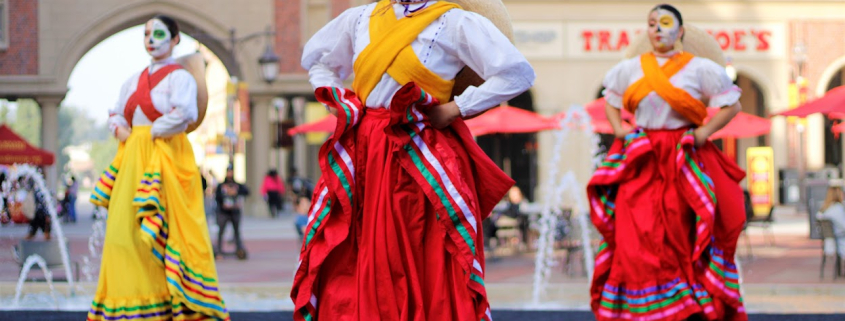Grupo Folklórico spotlights Mexican culture

In between the mile-long Dulce line and busy Target shoppers, the USC Village was transformed into a celebration of Mexican culture, including an ofrenda, papel picado and the star of the show: Grupo Folklórico del USC.
Saturday’s event marked the third annual showcase from Grupo Folklórico but only the second in-person performance celebrating Día de los Muertos.
After last year’s performance was held over Zoom, the audience’s excitement was tangible as they clapped and chanted throughout the event. The Latinx community gathered to cheer on the performers, honor the holiday and appreciate traditional Mexican folk dancing.
Keeping with the group’s mission to “educate the USC community about Mexican culture by performing traditional dances alongside folkloric music,” the dancers wore colorful long skirts and the ruffled tops of Sinaloa. For Día de los Muertos or Day of the Day, the group painted their faces in the calavera style — an homage to the idea that all are equal in death.
The group performed dances from all over Mexico, including Sinaloa, Veracruz, Chihuahua, Baja and Durango. The dances honored important groups throughout Mexican history including the Soldaderas, women soldiers in Mexico during the revolution who have since become feminist icons, and vaqueros, the first cowboys, who were mostly Indigenous Mexican men.
In between dances, Ivonne Rodriguez, the emcee, spoke about the importance of Día de los Muertos, emphasizing it as a day of love and family. In Mexican culture, Día de los Muertos is one of the most important holidays of the year. The holiday, which takes place Nov. 1 and 2, is about families reconnecting and celebrating the lives of their lost loved ones. For Keila Rodriguez, a member of Grupo Folklórico, dancing is the way she celebrates the holiday.
“Día de los Muertos means we’re representing our ancestors,” Rodriguez said. “We’re showing it through our dances of different regions throughout Mexico. We’re giving thanks that they came here, helped us and gave us a path to follow.”
Another way people celebrate Día de los Muertos is by honoring their ancestors through the ofrenda — an altar typically in a family’s home that honors deceased family members by putting their pictures alongside flowers, decorations and food. To continue this tradition, next to their stage, Grupo Folklórico made their own ofrenda full of pictures of loved ones and covered with marigolds, a traditional flower for the ofrenda which is often referred to as the flor de muerto, or flower of the dead.
To Diana Cuevas, a dancer with Grupo Folklórico and a sophomore majoring in computer science and business administration, being a member of Grupo Folklórico is not only about celebrating and giving thanks, but also about sharing her culture.
“I am from Mexican descent, so [my family and I] already celebrate Día de los Muertos,” Cuevas said. “So to be able to bring [Día de los Muertos] into the whole USC community, it’s really nice to be able to share that.”
For other members of Grupo Folklórico, the show is more than dancing; it is a way to connect people of a shared background. LeeAnna Villarrea, a junior majoring in journalism, joined the group after seeing its booth at the involvement fair in 2019 and quickly found a sense of community with Grupo Folklórico.
“Going to a PWI as a person of color can feel pretty lonely” Villarreal said. “To meet with people that have the same background as me two times a week, it’s so comforting.”

